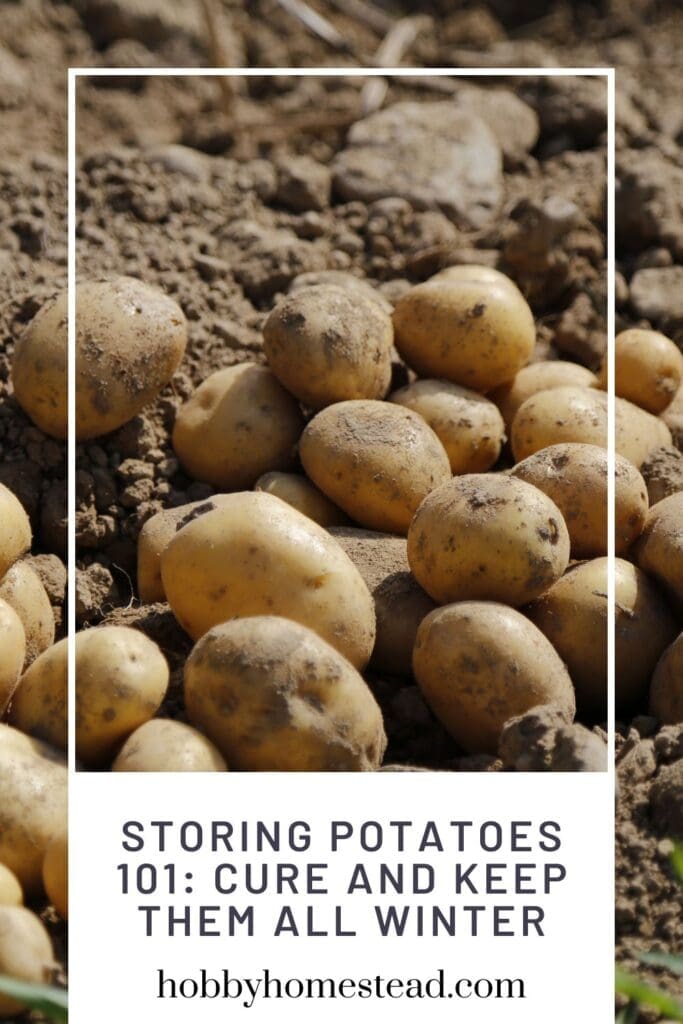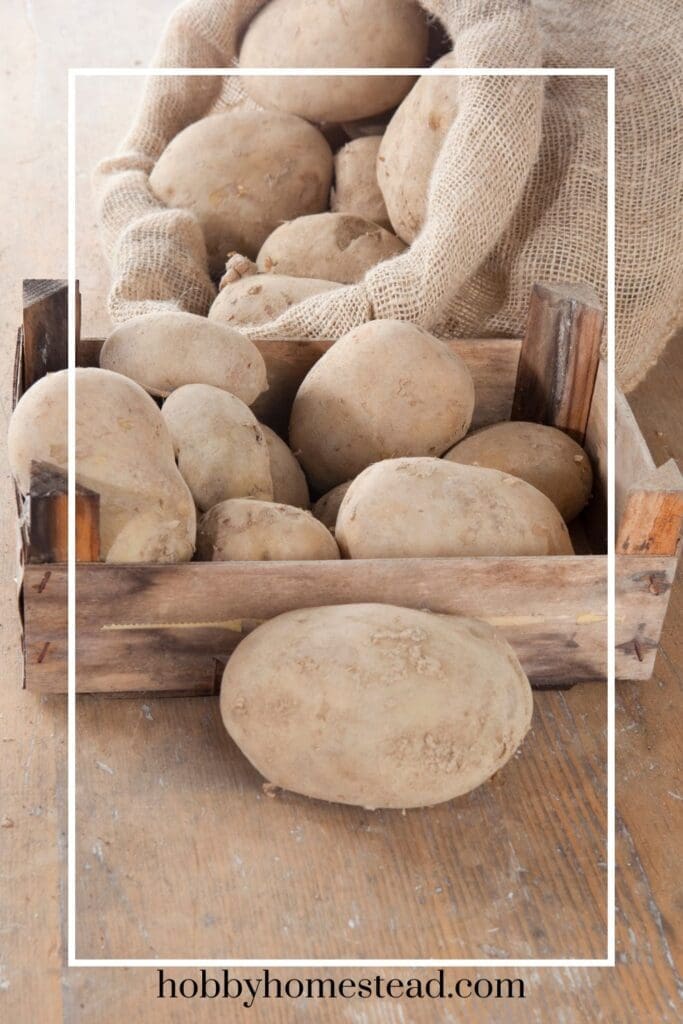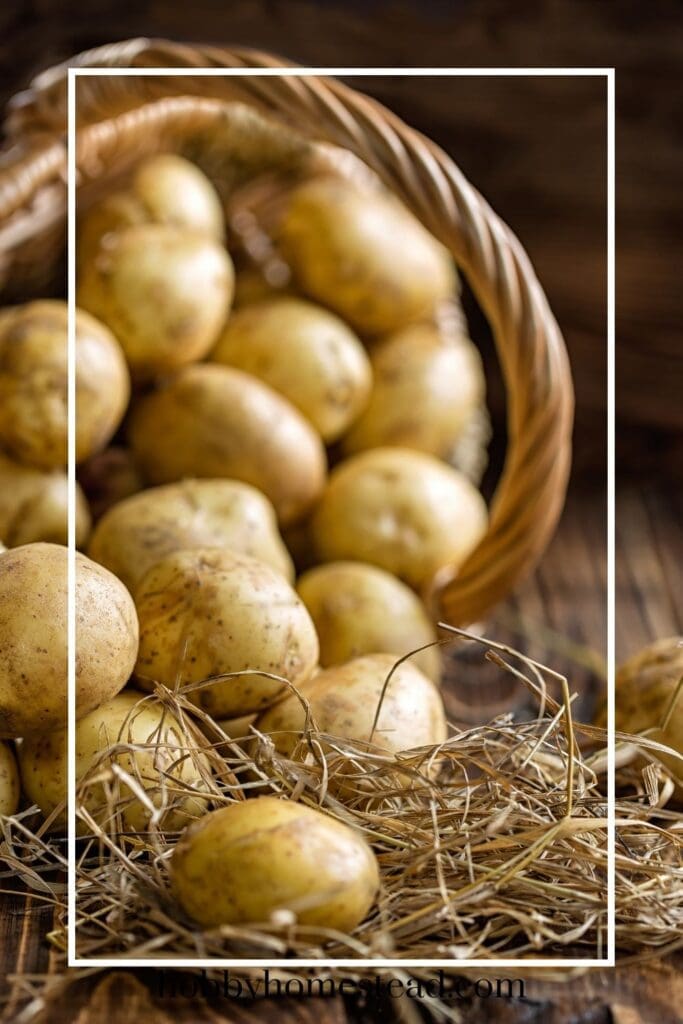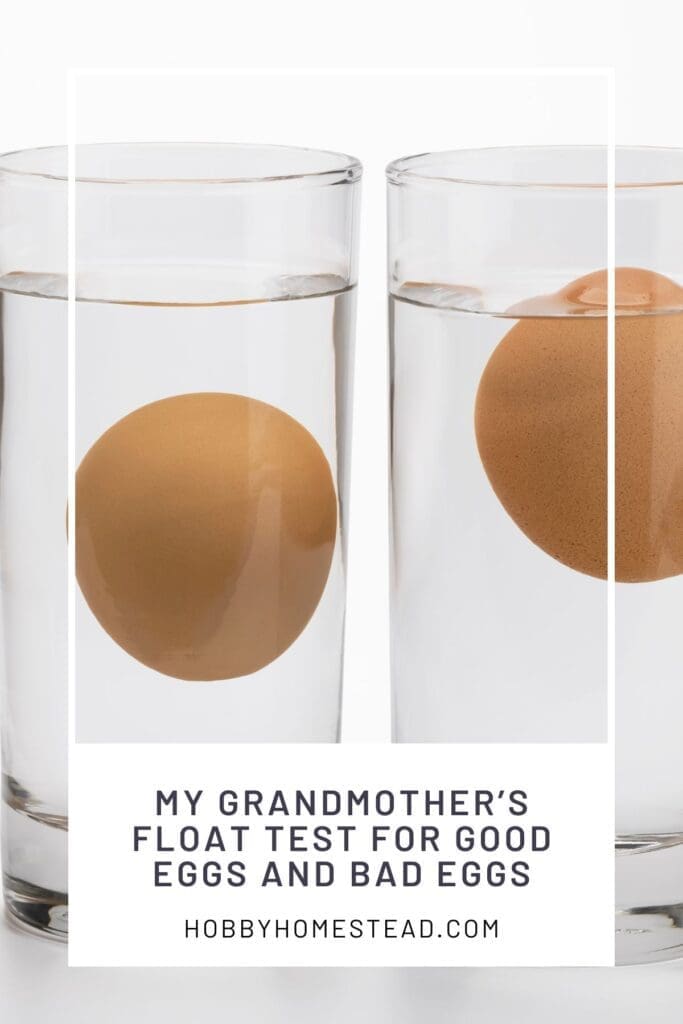Learn how to keep your potatoes all winter with this storing potatoes 101 guide. Whether you’re stocking up on grocery store potatoes, bringing home a few bags from the farmers market, or storing a just-harvested crop from your backyard garden, knowing how to store potatoes the right way makes a big difference.
The wrong environment, like a warm pantry, can cause them to sprout, shrivel, or turn green within weeks, as my daughter discovered in her own kitchen.
Meanwhile, my pantry, cooler and darker, keeps them fresh for much longer. The good news? With just a few adjustments in temperature, humidity, and airflow, you can extend the life of your potatoes and enjoy them throughout the winter months, no matter where they came from.

Storing Homegrown Potatoes
After a successful potato harvest, the next important step is knowing how to store your homegrown potatoes so they’ll last well into the winter months. And maybe even until the following year. Whether you grew red potatoes, Yukon Gold, or fingerling potatoes, taking the time to properly cure and store them can mean the difference between a long-lasting pantry staple and a bad potato pile in a few weeks.
This guide walks you through the best tips and storage methods. Including how to cure them, what storage temperatures to aim for, and the best place to store root crops like potatoes for long-term storage.
How Long Can You Store Potatoes?
Under the right storage conditions, potatoes can last anywhere from a few weeks to several months.
🥔 Storage Life by Potato Type
| Type of Potato | Storage Life | Notes |
| Late-season storage potatoes (e.g., Yukon Gold, Kennebec, Russet) | 4–6 months | Must be cured and stored in a cool, dark, humid space |
| Thin-skinned potatoes (e.g., red potatoes, new potatoes) | 2–4 weeks | Use quickly; store in fridge short term if needed |
| Fingerling potatoes | 1–2 months | Shorter storage life; best used soon after harvest |
| Grocery store potatoes | 1–2 months | Varies based on when they were harvested and how they were handled |
| Farmers market potatoes | 1–3 months | Check skin thickness; cure if not already cured |
🧊 Ideal storage temperature: 35–40°F
🌫️ Ideal humidity: 85–95%
🌑 Best environment: Dark, cool, well-ventilated space—like a root cellar, unheated basement, or garage
What Can Shorten Storage Life?
- Warm temperatures (like a kitchen pantry)
- Too much light (causes greening)
- Too little humidity (leads to shriveling)
- Ethylene gas exposure (from fruits like apples)
- Skipping the curing process
With the best storage conditions, late-harvest, thick-skinned potatoes can last well into late winter or even early spring, making them one of the best root crops to grow or buy in bulk.
Storing Potatoes 101
The key is to store potatoes in a cool dry place, like in the cabinet of a pantry, in a paper bag or cardboard box.
Step One: Cure Your Potatoes for Storage
Before you tuck those fresh potatoes away for the season, they need to go through the curing process. This allows small wounds in the skins of the potatoes to heal, which extends their storage life and helps prevent soft spots or rot later.
Here’s how to cure potatoes for best results:
- Harvest on a dry day, using a garden fork to gently lift potatoes from loose soil
- Brush off excess soil. Don’t wash the potatoes yet! Never wash your storing potatoes. As that will drastically shorten their storage life.
- Lay them in a single layer in a well-ventilated container (like wooden crates, burlap sacks, or trays)
- Keep them in a dark room or unheated basement at a moderate temperature (around 60°F) with high humidity
- Cure for about 10–14 days
This simple but important step helps develop thicker skin on storage potatoes, which is essential for long-term storage.
Step Two: Store Potatoes in the Right Conditions
Once your potatoes are cured, it’s time to move them to your storage area. The ideal temperature for storing potatoes is 35–40°F. Cool enough to keep them from sprouting, but not cold enough to damage the cells like in a refrigerator.
✅ Best Potato Storage Conditions:
- Cool temperature: 35–40°F
- High humidity: 85–95%
- Dark place: A dark room or root cellar prevents a green color from developing
- Good air circulation: Use wooden crates, cardboard boxes, or paper bags
- Keep them in a single layer or loosely piled—not crammed into plastic bags
Keep your stored potatoes away from apples, onions, and other fruits.
Many fruits release ethylene gas, which speeds up sprouting and spoilage in potatoes. Onions, when stored nearby, can also lead to cross-contamination of odors and faster deterioration. For best results, store potatoes separately in a well-ventilated container in a dark, cool space.
The best place to store potatoes at home is a cool basement, crawl space, or unheated garage, as long as it doesn’t drop below freezing. An unheated basement or traditional root cellar is ideal for the winter storage of root vegetables.
Storage Tips for Best Results
- Don’t wash your potatoes until just before use. Clean potatoes stored wet will spoil
- Avoid storing near apples or other fruits that release ethylene gas, which causes sprouting
- Check often for spoilage. Remove any soft spots, green parts, or rotting potatoes right away
- Keep different types of potatoes and thin-skinned potatoes (like new potatoes) separate from thick-skinned late-maturing varieties
- Avoid high temperatures and room temperature storage (like a kitchen cupboard) if you want your potatoes to last a long time
Short-Term vs Long-Term Storage
If you only plan to store potatoes for a few weeks, a paper bag in a dark place (like a pantry or cupboard away from the oven) will work.
But for long term storage, cooler, well-ventilated conditions are essential. Some types of potatoes, especially those grown for storage, have a pretty long shelf life when kept in the right storage temperatures.
Tip: Store sweet potatoes separately. They require warmer, drier storage and can spoil storage potatoes if mixed.

Does the Type of Potato Matter for Storage?
Yes, the variety of potato plays a big role in how well it stores over time. Some potatoes are bred for immediate use, while others are ideal for long-term storage through the winter months.
🥔 Storage Potatoes (Best for Long-Term Storage):
- Thick skins and dense flesh
- Better resistance to sprouting and shriveling
- Often late-maturing varieties
- Great for storing in a cool basement, root cellar, or unheated garage
- Examples:
- Yukon Gold
- Kennebec
- Russet Burbank
- German Butterball
🥔 New Potatoes and Thin-Skinned Varieties (Short-Term Use):
- Harvested early and have thin, delicate skins
- More moisture and less protection. So they spoil faster
- Best kept in the fridge for a short term, or used quickly
- Examples:
- Red potatoes
- Fingerling potatoes
- Any new potatoes harvested before full maturity
Tip: Keep thin-skinned and thick-skinned potatoes stored separately if possible. Mixing them can shorten the life of the more delicate ones.
If you’re buying from the grocery store or farmers market, check the variety name and feel the skin.
For homegrown potatoes, let them fully mature and cure to toughen up the skin for better storage.
Troubleshooting Common Potato Storage Problems
Even with the best intentions, things can go wrong when storing potatoes. Here’s how to spot issues early and what to do about them:
🥔 1. Potatoes Are Sprouting Too Soon
Why it happens:
- Warm temperatures
- Exposure to light
- Ethylene gas from fruits (like apples or bananas)
What to do:
- Move them to a cooler, darker place—ideally 35–40°F
- Store away from other produce
- Remove sprouts gently and use sprouting potatoes soon—they’re still edible if firm and not green
🥔 2. Potatoes Turn Green
Why it happens:
- Exposure to light during or after storage causes a green pigment (chlorophyll) to form
- Green areas often contain solanine, a bitter compound that can be toxic in large amounts
What to do:
- Cut away green parts before cooking
- Prevent future greening by storing in a dark room, paper bag, or covered crate
- Never eat green potatoes that taste bitter or have spread greening
🥔 3. Potatoes Are Shriveling or Wrinkling
Why it happens:
- Low humidity or storage in a dry place
- Long storage at room temperature
What to do:
- Increase humidity with a damp towel nearby or switch to a more humid space like a root cellar
- Use paper bags, wood shavings, or burlap sacks to help retain moisture
- Use shriveled potatoes quickly—they’re still safe if not rotten
🥔 4. Potatoes Are Rotting or Growing Mold
Why it happens:
- Stored wet, especially if not cured properly
- Poor air circulation
- Stored in plastic bags that trap moisture
What to do:
- Toss rotten or moldy potatoes right away
- Check the rest—one bad potato can ruin the batch
- Use a well-ventilated container like wooden crates or cardboard boxes
- Always cure potatoes before storage, and never store them damp
🥔 5. Potatoes Have Soft Spots
Why it happens:
- Bruising during harvest or handling
- Breakdown of tissues from excess moisture
What to do:
- Use soft potatoes right away or discard
- Handle carefully during harvest with a garden fork
- Avoid stacking large amounts on top of each other—stick to a single layer if possible

🥔 Potato Storage Do’s & Don’ts – Quick Reference Guide
✅ DO:
- ✔ Cure potatoes for 10–14 days before long-term storage
- ✔ Store in a cool, dark, and humid place (35–40°F)
- ✔ Use paper bags, burlap sacks, or wooden crates
- ✔ Keep potatoes in a single layer or loosely piled for airflow
- ✔ Remove sprouts and soft spots regularly
- ✔ Separate thin-skinned and thick-skinned varieties
- ✔ Check stored potatoes weekly for spoilage
- ✔ Store potatoes away from fruits and onions
❌ DON’T:
- ❌ Store in plastic bags or sealed containers without airflow
- ❌ Expose to light (causes green color and solanine buildup)
- ❌ Wash potatoes before storage—store them dry
- ❌ Store near apples, bananas, or other ethylene gas producers
- ❌ Keep in a warm pantry or at room temperature long term
- ❌ Stack in large amounts that cause bruising or poor air circulation
- ❌ Store potatoes next to apples, bananas, or onions. They cause sprouting and spoilage
The Best Way to Store Potatoes
The best solution for storing homegrown potatoes depends on your space, climate, and how many potato plants you’ve harvested. Whether you’re using wood shavings, cardboard boxes, or traditional burlap sacks, following a proper curing process and storing your potatoes in a dark, cool, and humid space will keep them fresh, firm, and flavorful for months to come.
With the right potato storage method, even large amounts of raw potatoes can be safely stored all through the winter months, helping you make the most of your growing season and enjoy the best potatoes from your garden whenever you need them.


